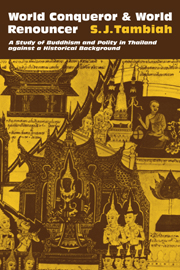 World Conqueror and World Renouncer
World Conqueror and World Renouncer Book contents
- Frontmatter
- Contents
- Acknowledgments
- PART ONE
- PART TWO
- 13 The Composition and Distribution of Religious Personnel: What the Figures Say
- 14 Monkhood as an Avenue of Social Mobility
- 15 Monastic Careers and Monastic Network
- 16 Patronage of the Sangha and the Legitimation of the Polity
- 17 Reformism and Ideological Transformation Based on Tradition
- 18 Missionary Monks (Thammathud) and National Development
- 19 The Politics of National Development and the Symbols of Legitimacy
- 20 Dialectical Tensions, Continuities, Transformations, and the Uses of the Past
- Bibliography
- Index
19 - The Politics of National Development and the Symbols of Legitimacy
Published online by Cambridge University Press: 10 November 2010
- Frontmatter
- Contents
- Acknowledgments
- PART ONE
- PART TWO
- 13 The Composition and Distribution of Religious Personnel: What the Figures Say
- 14 Monkhood as an Avenue of Social Mobility
- 15 Monastic Careers and Monastic Network
- 16 Patronage of the Sangha and the Legitimation of the Polity
- 17 Reformism and Ideological Transformation Based on Tradition
- 18 Missionary Monks (Thammathud) and National Development
- 19 The Politics of National Development and the Symbols of Legitimacy
- 20 Dialectical Tensions, Continuities, Transformations, and the Uses of the Past
- Bibliography
- Index
Summary
To evaluate fully the nature and degree of the sangha's legitimation of the polity today in Thailand, we must first see the polity for what it is. The revolution of 1932, its social origins and the course that it took, provides us with some paradoxes and ambiguities that provide the key to the understanding of the stock of symbols that gives meaning to politics today and which in turn is actively manipulated by those in power.
We have already noted the social origins of the promoters of the revolution. They represent the newly educated army officers and civilians of commoner status whose object was to push aside the absolute monarch and his royal princes and select nobles, and to exercise their power. Note that their constituncy was (and has been ever since) the armed services, the civil service, and members of the governmental bureaucracy (and also the professions that usually have governmental association); they have never represented in any direct sense the masses, especially the rural population. We have also already noted the second feature about the revolution: It progressively became dominated by cliques of the armed forces whose form of government from 1939 to 1944, and then again from 1950 to the present, has taken an unambiguously authoritarian character.
But the paradoxical element is that the revolution of 1932 introduced into Thai politics certain ideas that have served as political values and symbols that are periodically invoked and manifest salience even as the generals periodically violate them.
- Type
- Chapter
- Information
- World Conqueror and World RenouncerA Study of Buddhism and Polity in Thailand against a Historical Background, pp. 472 - 514Publisher: Cambridge University PressPrint publication year: 1976


